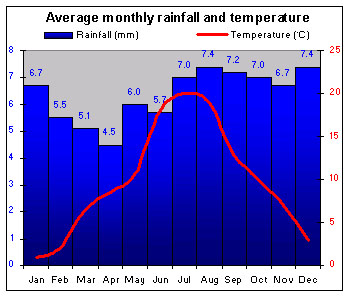COUNTRY INFORMATION |
Introduction |
Lying in the Atlantic Ocean, off the west coast of Great Britain, the Irish republic occupies about 85% of the island of Ireland. Low coastal mountain ranges surround a central basin with lakes, hills, and peat bogs. Centuries of struggle against English colonialism led to the formation of the Irish Free State in 1922 and full sovereignty in 1937. Efforts to resolve the Northern Ireland conflict center on the 1998 Good Friday accord, under which Ireland gave up its territorial claim. |
|
Climate |
 |
Moderated by the Gulf Stream, the Irish climate is mild, equable, and wet. The mean annual temperature is 12°C (54°F). |
|
People |
| Languages |
English, Irish Gaelic |
|
| URBAN/RURAL POPULATION DIVIDE |
|
|
|
The population is 95% ethnic Irish. The influence of the Roman Catholic Church is declining. Ireland is now a country of net immigration, reversing the trend of the last 150 years. |
|
Economy |
| GNP (US$) |
85979
|
M |
GNP World rank |
39
|
|
| Inflation |
6 |
% |
Unemployment |
4 |
% |
|
StrengthsThe "Celtic tiger" – one of Europe's fastest-growing economies: real GDP growth of 9% a year in the latter half of the 1990s. Trade surplus. Low inflation. Efficient agriculture and food processing. Expanding high-tech sector: electronics account for 25% of exports. Large recipient of EU infrastructure aid. Highly educated workforce. WeaknessesMany key sectors owned by overseas multinationals. Danger of economy overheating. Housing shortage. Rapid growth is now straining infrastructure. |
|
Politics |
| Lower house |
Last election |
2002 |
Next election |
2007 |
| Upper house |
Last election |
2002 |
Next election |
2007 |
|
In 1973, an FG–LP coalition took power, marking the end of FF as the traditional party of government – a role it had held since 1932. Government leadership then alternated between FG and FF. The latter, dominating an FF–PD coalition under Bertie Ahern as taoiseach (prime minister) from 1997, improved its position in the April 2002 elections but without winning a majority. |
|
Resources |
| Minerals |
Lead, zinc, natural gas, silver, coal |
|
| Oil reserves (barrels) |
No data |
Oil production (barrels/day) |
Not an oil producer; refines 56,000 b/d |
|
Oil has been found off the south coast. Studies suggest that this may be in commercially exploitable quantities. |
|
Health |
| Life expectancy |
77 |
Life expect. World rank |
28 |
| Population per doctor |
435 |
Infant mortality (per 1000 births) |
6 |
|
|
|
| Principal causes of death |
Heart diseases, cancers, accidents |
|
Free care is means tested; about one-third of people qualify. Others pay to visit their doctor and for prescriptions, and there is a modest charge for hospital care. |
|
Education |
| Literacy |
99 |
% |
Expend. % GNP |
5 |
%
|
|
| PERCENTAGE OF POPULATION IN FULL TIME EDUCATION |
|
| Primary |
100 |
% |
Secondary |
100 |
% |
Tertiary |
45 |
% |
|
The Roman Catholic Church runs many schools. Increased education spending has resulted in a skilled workforce. |
|
Wealth |
| Cars |
272 |
per 1,000 population |
| Telephones |
420 |
per 1,000 population |
| Televisions |
399 |
per 1,000 population |
|
Living standards for those with jobs are rising steadily. Welfare for those not in work is low by OECD standards.
|
History |
English colonization, begun in 1167, was reinforced after 1558 by anti-Catholic legislation and settlement of Scottish Protestants in the north. - 1845–1855 Famine. One million die, 1.5 million emigrate.
- 1919–1921 Anglo-Irish war after republican Sinn Féin proclaims Irish independence.
- 1922 Irish Free State set up.
- 1973 FG/LP alliance wins elections ending FF's ascendancy since 1932.
- 1990 Mary Robinson elected first woman president.
- 1995 Referendum favors divorce.
- 1998 Good Friday accord on Northern Ireland.
- 2001 Voters reject EU treaty on expansion.
- 2002 Euro fully adopted. FF retains power.
|
|